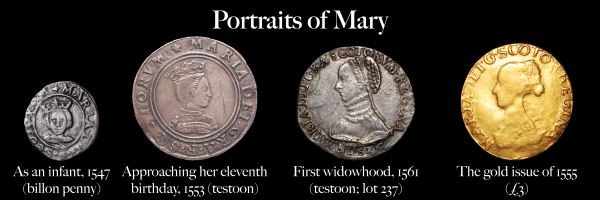
PREV ARTICLE
NEXT ARTICLE
FULL ISSUE
PREV FULL ISSUE
NOTES ON SCOTTISH COIN DESIGNHere's Allan Davisson's article on Scottish coin design. Davisson's Auction 43 of the Leland Scott Collection of the Coins of Scotland closes this week. -Editor
A Style of Their Own
A few notes on Scottish coin design from David to Mary
Scottish coinage began during the Anarchy and Stephen's reign (1135-1154). After the death of Henry I in 1135, Stephen of Blois, despite an oath to Matilda, Henry I's daughter, seized the English throne. The next year, David I moved south to support Matilda, his niece. Capturing the mint at Carlisle resulted in the first coinage that is considered
Around 1170, about five years into his reign and not long after the introduction of the short cross penny in England, William I began the David II's coinage was influenced by English coinage under Edward III. Though his effort at a gold noble proved short-lived (only four examples are known), his introduction of the groat, a four-penny piece, paralleled the English series and was a dominant part of Scottish coinage until the reign of James V. Similar in terms of overall design to the English groat until the reign of James III, the Scottish groat took an unusual artistic turn in 1471 with a realistic Renaissance image of the young king replacing the stylized facing medieval bust that was the standard at the time. This was an era of humanistic revival in the arts in Italy and realistic portraiture was one of the most visible signs of this changed world view. This reawakening made its way to Scotland and influenced coinage there well before this new spirit influenced coin artistry in the rest of Britain. A more regular gold coinage in Scotland came during the reign of Robert III (1390-1406) with the gold lion that reflected the gold ecu d'or of French king Charles VI. (Note lot 21 in this sale.) From there, the gold issues of Scotland continue to show style and imagination—riders, unicorns, bonnet pieces, hat pieces and, ultimately the beautiful coins of Mary and the varied gold issues of James VI. The Italian and, later, French influences on Scottish coinage peaked during the reign of Mary. John Achesoun was the master of the mint and the 1562-1563 testoon of Mary was produced under his leadership with dies from the French artist Antoine Brucher at the Paris mint. The earlier portrait testoon of Mary as she was nearing eleven years old had been his work as well.
To read the complete article, see:
To browse the online and print catalogs, see:
To read the earlier E-Sylum article, see:
Wayne Homren, Editor The Numismatic Bibliomania Society is a non-profit organization promoting numismatic literature. See our web site at coinbooks.org. To submit items for publication in The E-Sylum, write to the Editor at this address: whomren@gmail.com To subscribe go to: https://my.binhost.com/lists/listinfo/esylum All Rights Reserved. NBS Home Page Contact the NBS webmaster 
|

